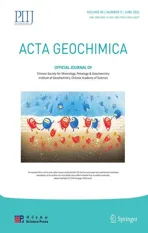Petrology and geochemical framework of dolerites dykes of Temte´,North Cameroon,Central Africa
2021-07-02MeyAtourBardintzeffFagnyMefireNkouandouTchameniDinamou
M.Mey Atour ·J.M.Bardintzeff·A.Fagny Mef ire·O.F.Nkouandou,3·R.Tchameni·A.Dinamou
Abstract The Temte´basement in North Cameroon is crosscut by dyke swarms with N 20°–40°trending,including dykes 15–30 m wide,up to 3 km-long.Representative rocks exhibit intersertal to sub-ophitic textures.Electron microprobe analyses identif ied diopside,augite,pargasite,biotite,Ti-magnetite,plagioclase,and sanidine.Whole-rock ICP-MS and ICP-AES chemical analyses showed compositions of basaltic andesite,basaltic trachyandesite and trachyandesite in composition.Igneous differentiation was likely governed by fractional crystallization associated with limited f luid metasomatism.Some lavas could have been moderately contaminated by crustal materials during feeding of local cracks through turbulent magma f lows.Discrimination geochemical diagrams and immobile trace and REE element ratios show that the mantle source of Temte´dolerites was a deep phlogopitebearing EMII mantle component and has undergone moderate to high partial melting rate.Correlations of f ieldwork and analytical data with previous results evidence the Temte´dolerite dyke swarms as f ingerprints of crustal extension accompanying regional uplift in an active continental margin when early rifting led to the formation of the Poli marginal basin.
Keywords Dolerite·Dyke·Temte´·Poli·Cameroon·Central Pan-African Fold Belt
1 Introduction
In Central Africa,dolerites are the least studied intrusive rocks despite their importance in deciphering the geodynamic and geochemical evolution of the African continental basement.Dolerite dyke swarms are known worldwide as keys for geodynamic interpretation(Srivastava 2011)and constitute a common feature of many terranes(Tarney 1992;Worthing 2005)including the Central Pan-African Fold Belt,where they are assumed to be either Late Pan-African(Nkouandou et al.2015,2016)or Paleoproterozoic(Vicat et al.1997).The geodynamic evolution and the timing of tectonic episodes leading to the formation of Pan-African Fold Belt in Central Africa have been diversely interpreted(Toteu 1990;Toteu et al.2004;Ngako et al.2006).Numerous models include:(1)an active continental margin-type environment,where early rifting led to the formation of marginal basins(Toteu 1990),(2)a sequence of continent–continent collisions(Toteu et al.2004)or(3)combined effects of Eburnian and Pan-African orogenies(Toteu et al.2001).They have been proposed to decipher the evolution of the Central Pan-African basement,with reference to Poli crustal basement in Northern Cameroon.Dolerite dykes as time markers of tectonic episodes are widespread in the Temte´area,North Western Poli region,in the Northern domain of Central Pan-African Fold Belt.Such occurrences suggest that the overall tectonic evolution of the Poli basement has been controlled either by extensional settings or by a convergence initiated during the early collisional stage.Up to now,no systematic petrology and geochemical investigation have been carried out on Poli doleritic dyke swarms,aiming to evidence their tectonic signif icance.
This work focuses on the petrology and geochemistry of Temte´dolerite dykes in view to offer preliminary information on their compositions and the nature of mantle source and to discuss their relevance on the tectonic construction of the Poli basement.
2 Geological setting
The Temte´basement like the entire Poli region is part of the so-called‘Poli basin’located in the North-West domain of Pan-African Fold Belt(Fig.1).This domain is limited south by the Tchollire-Banyo shear zone(TBSZ),a potential suture zone within the Central Africa Orogenic Belt(Nomo Negue et al.2017).The Poli basin basement consists of schist and gneiss units,composed of greywacke-type metasediments,with interlayered tholeiite and alkaline metavolcanites,as well as of pre-,syn-to postkinematic granitoids,crosscut by dolerite and microgranite dykes(Toteu 1990;Toteu et al.2006).The chronology of tectono-magmatic and sedimentary events which have affected the Poli basement has been outlined by Toteu et al.(2001):(1)ca.800 Ma early rifting,emplacement of tholeiitic and alkaline volcanic rocks,and greywacke deposition(Toteu et al.1987);(2)630–620 Ma compressional D1 deformation,medium-to high-pressure metamorphism,and emplacement of maf ic to intermediate calcalkaline plutonic rocks;(3)580±60 Ma D2 deformation,anatexis,and emplacement of granitoids,and(4)ca.550 Ma rapid uplift and emplacement of high-level posttectonic granites.A continental active margin environment has been proposed(Toteu 1990;Toteu et al.2006)for the formation of marginal basins.The occurrence of dolerite dyke swarms in Poli basin has been interpreted by Toteu et al.(2004)as key indicators of fragmentation periods.This hypothesis implies multiple periods of emplacement of dyke swarms in the Poli basin.

Fig.1 A Location of Cameroon in Central Africa,B Geological map of Cameroon redrawn after Toteu et al.(2006).CCSZ=Central Cameroonian Shear Zone,KCF=Kribi-Campo Fault,SSZ=Sanaga Shear Zone,TBSZ=Tchollire–Banyo Shear Zone,c Detail of Temte´geological area adapted after Dumont et al.(1985):1.Poli series,2.Te´te´orthogneiss,3.Bakonwa type granite,4.Non differentiated gneiss,5.Wangaı¨type granite,6.Gode´Massif,7.Dolerite dyke
3 Fieldwork
Dolerites dykes form swarms around Temte´and crosscut gneisses and granitoı¨ds of the basement(Fig.1c).The trending directions of composite dykes vary from N20°E to N40°E.Individual dykes are from 15 to 25 m-wide(even 30 m).Outcroppings have a length of 200 to 300 m before disappearing and reappearing not so far away.When plotting on Google Earth,it appears that they may constitute units up to 3 km-long(Fig.2).As the contact with the basement is concealed by altered products,the dip of each dyke is assumed to be sub-vertical.Dykes are exposed as an arena of angular blocks of 20 cm to 1.2 m in size,coated by 0.5 to 1 cm-thick brown patina.About 20 samples were collected in the cores of the intrusions.Hand specimen display aphanitic to phaneritic textures.The freshest samples are composed of up to 3 mm whitish plagioclase,brownish-green amphibole,1 to 1.5 mm black clinopyroxene,and oxides dominating the dark groundmass(Fig.2b).Rare 2–6 cm crustal enclaves of granitoid composition have been found in some outcrops.

Fig.2 Representative Temte´giant dyke(A),exposed as angular blocks of dolerite,trending N20°E,containing feldspars and maf ic phases in a greenish grey matrix(B)
4 Petrography
Under a microscope,thin sections exhibit intersertal to subophitic textures(Fig.3a–d).They are composed of:(1)20 vol.%of up to 1.3×2 mm euhedral and sieve plagioclase crystals,containing oxide inclusions,(2)>15 vol.%euhedral clinopyroxene phenocrysts(Fig.3a–c),with frequent inclusions of oxides and sometimes altered into oxides(Fig.3c).They constitute the main oikocryst phases,(3)<10 vol.%squat feldspar phenocrysts(Fig.3a),and(4)<5 vol.%and 0.7×1 to 1.2×2.1 mm euhedral amphibole phenocrysts,containing oxides inclusions,partially destabilized into oxides with resorbed rims(Fig.3b).All phases show a preferred orientation.Plagioclase and clinopyroxene microlites as well as oxides microcrysts occur in the matrix.Note that,in all lavas,biotite is lacking as phenocrysts but occurs in the matrix,where they are frequently rimmed with oxides microcrysts(Fig.3b).

Fig.3 Photomicrographs showing main characteristic intersertal textures of Temte´dolerites.a,c the scale bar equals 500μm;b,d the scale bar equals 200μm.cpx=clinopyroxene,ox=oxides,pl=plagioclase,amp=amphibole,bt=biotite,k-felds=alkali feldspar.(a)euhedral clinopyroxene phenocrysts in a matrix of feldspar,oxides and plagioclase(trachyandesite sample DN16).(b)amphibole phenocrysts,microphenocrysts of K-feldspar,plagioclase and oxides(basaltic trachyandesite sample DN23).(c)clinoyroxene phenocryst altered into oxides in a matrix of plagioclase and oxides(basaltic trachyandesite sample DN25).(d)plagioclase skeletal phenocryst including microlites of clinopyroxene,microcrysts of oxides(basaltic trachyandesite sample DN21)
5 Analytical methods
Five thin polished sections have been made from representative samples at GEOPS Laboratory,University of Paris-Saclay,France.Mineral analyses have been performed at the electron microprobe CAMECA SX 100 at the Service Camparis,UPMC,University Paris-Sorbonne,France.Operating conditions were accelerating voltages,beam currents and counting times as follows:clinopyroxene:15 kV,40 nA,20 s,except Ti(30 s);K-feldspar,titanomagnetite:20 kV,40 nA,Si,Ca,Ni:10 s;Mn:25 s;Cr;15 s;Al:30 s;Ti,Fe,Mg:40 s;amphibole:15 kV,21 nA;Si,Al,Mg,Na,K,and Ba:15 s;Ti,Ca:20 s,Fe,Mn:25 s,F,Cl:30 s;biotite:15 kV,10 nA,20 s,Al:30 s.Standards were a combination of natural and synthetic minerals.Data corrections were made using the PAP method correction(Pouchou and Pichoir 1991).Wholerock analyses were made by ICP–MS and ICP–AES methods to determine major,trace,and rare earth elements at ACME Analytical Laboratories,Vancouver,British Columbia,Canada.Major and trace elements were carried out from pulps.0.2 g of rock powder was fused with 1.5 g LiBOand then dissolved with 4 acid digestions.Analytical precisions vary from 0.04 to 0.1%for major elements;from 0.1 to 0.5 ppm for trace elements;and from 0.01 to 0.5 ppm for rare earth elements.Loss On Ignition(LOI)has been determined by weight difference after ignition at 1000°C.
6 Mineral chemistry
Mineral chemical compositions of Temte´dolerites are summarized in Table 1.In basaltic andesite sample DN22,clinopyroxene oikocryst shows diopside composition(Wo45.51,En39.85,Fs14.64)while clinopyroxene phenocrysts have augite composition (Wo39.29–43.03,En42.78–45.50,Fs14.19–15.22)(Fig.4a),following the classif ication scheme of Morimoto et al.(1988).AlO(5.84 wt%),TiO(2.02 wt%)and NaO (0.44 wt%)amounts in the oikocryst are relatively high in comparison with phenocrysts: AlO(2.88–3.80 wt%), TiO(1.03–1.30 wt%) and NaO (0.27–0.42 wt%). Mg#(=100 Mg/Mg+Fe)ratios are lower(89)in clinopyroxene oikocrysts than in clinopyroxene phenocrysts(93.6–94.6).
In trachyandesite sample DN 16,amphibole phenocrysts are calcic and pargasite after the classif ication scheme of Leake et al.(1997).TiOcontents are low(2.05–2.33 wt%)and MgO contents are constant(12.10–12.15 wt%)for Mg numbers of 60.5–60.9.NaO contents are also constant(2.6–2.8 wt%)as well as KO contents(0.8–0.9 wt%).A single mica crystal is biotite with 5.44 wt%of TiOfor 13.07 wt%of AlO.Fe#(=100Fe/(Fe+Mg))ratio is high(70.15).Oxide minerals are Ti–magnetite in composition(TiO:12.54–30.01 wt%and FeOt:62.27–76.54 wt%).
In trachyandesite sample DN 24,feldspar crystals(Fig.4b,Table 1)is sanidine with Or 46.91–81.15,Ab17.63–49.66,An1.22–3.44.FeO contents are low(0.44 wt%).

Fig.4 Representative mineral compositions.a clinopyroxene in Wo–En–Fs triangle(after Morimoto et al.1988)and b alkali feldspar in Or-Ab-An triangle
7 Geochemistry
Major and trace element analyses of the representative Temte´dolerites are listed in Table 2 and discriminated trough the IUGS TAS(NaO+KO)vs.SiOdiagram,LOI free recalculated(after Le Maitre 2002).Note that LOI is high,between 2.6 and 6.2 wt%,indicating rather weathered samples.Rocks are basaltic andesite,basaltic trachyandesite,and trachyandesite(Fig.5).Silica contents range from 49.1 to 55.1 wt%(52.4 to 56.8 when recalculated to 100 without LOI).TiOcontents,through TiO-rich lavas,show large variations with the highest content(TiOup to 3.05 wt%)found in basaltic trachyandesites.MgO contents are relatively high in basaltic andesite(6.86 wt%MgO),corresponding to a calculated value of Mg#(=100MgO/40.32/(MgO/40.32+FeOt/71.87))=53.9,higher than 27.2 in basaltic trachyandesite(Table 2).Alkali contents show the same variation trend as silica with very high contents(NaO+KO up to 8.34 wt%,8.6 when recalculated)in trachyandesite lava.CIPW norms show that lavas are quartz normative(0.8 to 3.1 wt%)dolerites,except olivine-normative basaltic andesite DN22(1.3 wt%)and basaltic trachyandesite DN20(6.5 wt%).
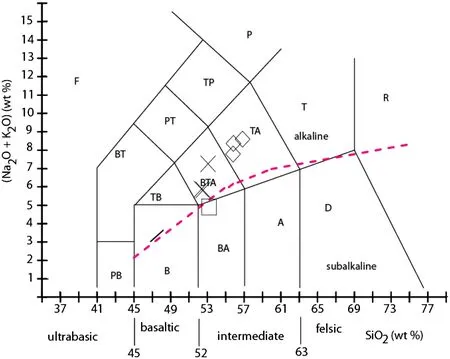
Fig.5 TAS diagram for Temte´dolerites after Le Maitre(2002).Pink dashed line separates subalkaline and alkaline f ields(after Miyashiro 1978).PB:Picobasalt,B:Basalt and Basanite,TB:Trachybasalt,BTA:Basaltic trachyandesite,BA:Basaltic andesite,A:Andesite,D:Dacite,TA:Trachyandesite,T:Trachyte,R:Rhyolite,P:Phonolite,TP:Tephriphonolite,PT:Phonotephrite and F:Foidite
Compatible transitional elements Ni(up to 123 ppm),Co (40.3–21.2 ppm), V (198–106 ppm), and Cu(57.0–9.5 ppm)contents are low and sometimes below the detection limit(<20 ppm)but are relatively higher in basaltic lavas compared to slightly evolved ones.Incompatible alkaline and alkaline-earth elements Ba,Rb,and Sr contents are low in basaltic andesite compared to basaltic trachyandesite to trachyandesite,where they are higher:Rb up to 139.8 ppm and Ba up to 1324 ppm.Sr contents are high in basaltic trachyandesite(520–638 ppm)and in trachyandesite(603–785 ppm).

Mineral Clinopyroxene DN22 K-feldspar DN24 Biotite Amphibole DN16 Ti-magnetite DN16 Sample DN22 DN22 DN24 DN16 DN16 DN16 Type Oikocryst Phenocryst SiO2 48.58 50.36 51.42 72.54 63.69 36.91 41.26 41.81 0.06 0.07 TiO2 2.02 1.30 1.03 0.07 5.44 2.05 2.33 30.01 12.54 Al2O3 5.84 3.80 2.88 15.87 19.02 13.07 12.77 13.75 0.58 2.42 FeOt 8.66 8.66 9.12 0.44 22.22 13.23 13.07 62.27 76.54 MnO 0.16 0.13 0.26 0.05 0.16 0.20 0.13 1.98 0.90 MgO 13.20 14.54 15.67 0.02 9.46 12.10 12.15 0.03 0.03 CaO 20.98 20.34 18.83 0.55 0.22 0.05 9.81 10.44 0.03 0.06 Na2O 0.44 0.42 0.27 4.36 1.79 0.13 2.82 2.59 0.00 0.00 K2O 6.26 12.52 8.40 0.77 0.92 0.00 0.00 Sum 99.88 99.55 99.48 99.65 97.75 95.84 95.01 97.19 94.96 92.56 Si(apfu) 1.812 1.877 1.914 3.190 2.973 5.654 5.946 5.901 Ti 0.057 0.036 0.029 0.822 1.047 0.626 0.223 0.247 0.585 0.244 AlIV 0.188 0.123 0.086 2.346 2.054 2.099 0.018 0.074 AlVI 0.069 0.044 0.041 0.013 0.115 0.188 Fe3+ 0.049 0.056 0.011 0.000 0.000 1.349 1.658 Fe2+ 0.091 0.056 0.050 0.017 2.846 1.699 1.638 0.001 0.000 Mg 0.734 0.808 0.870 2.159 2.600 2.555 0.001 0.001 Mn 0.005 0.004 0.008 0.021 0.024 0.016 0.043 0.020 Ca 0.839 0.812 0.751 0.026 0.011 0.008 1.514 1.578 Na(M4) 0.486 0.422 B 2.000 2.000 Na(A) 0.302 0.286 Na 0.032 0.031 0.019 0.372 0.162 0.038 K 0.351 0.745 1.642 0.142 0.166 A 0.444 0.451 Wo(wt%) 45.51 43.03 39.29 En 39.85 42.78 45.50 Fs 14.64 14.19 15.22 Mg# 89.01 93.56 94.60 43.13 60.47 60.93 Or(wt%) 46.91 81.15 Ab 49.66 17.63 An 3.44 1.22
Ba/Rb ratios are low in basaltic andesite(4.54)and high in other lavas,with the highest contents in basaltic trachyandesite(13.05)(Table 3).Rb/Sr ratios are low in all lavas with values less than 0.25.Y contents are relatively low in basaltic andesite(19.7 ppm)and higher in basaltic trachyandesite (27.8 ppm).Zr(131.6–413.8 ppm),Hf(3.6–10.4 ppm),Ta(0.9–1.8 ppm),Th(5.0–14.1 ppm),and Nb(9.7–28.4 ppm)contents increase from basaltic andesite to trachyandesite.Y/Nb ratios are high in basaltic andesite(2.03)and are between 1.13 and 1.32 in basaltic trachyandesites while basaltic trachyandesites have lower values≤1.
Zr/Hf ratios are relatively constant(36.56–40.83),while Nb/Ta ratios are low in basaltic andesite(10.78)compared to other lavas,where values are relatively constant(14.61–17.75).Th/Yb(2.56–4.29)and Ta/Yb(0.54–0.76)ratios are low in basaltic andesite and basaltic trachyandesite,while trachyandesites are characterized by higher ratios(up to 10.14 and 1.15 respectively,see Table 3).
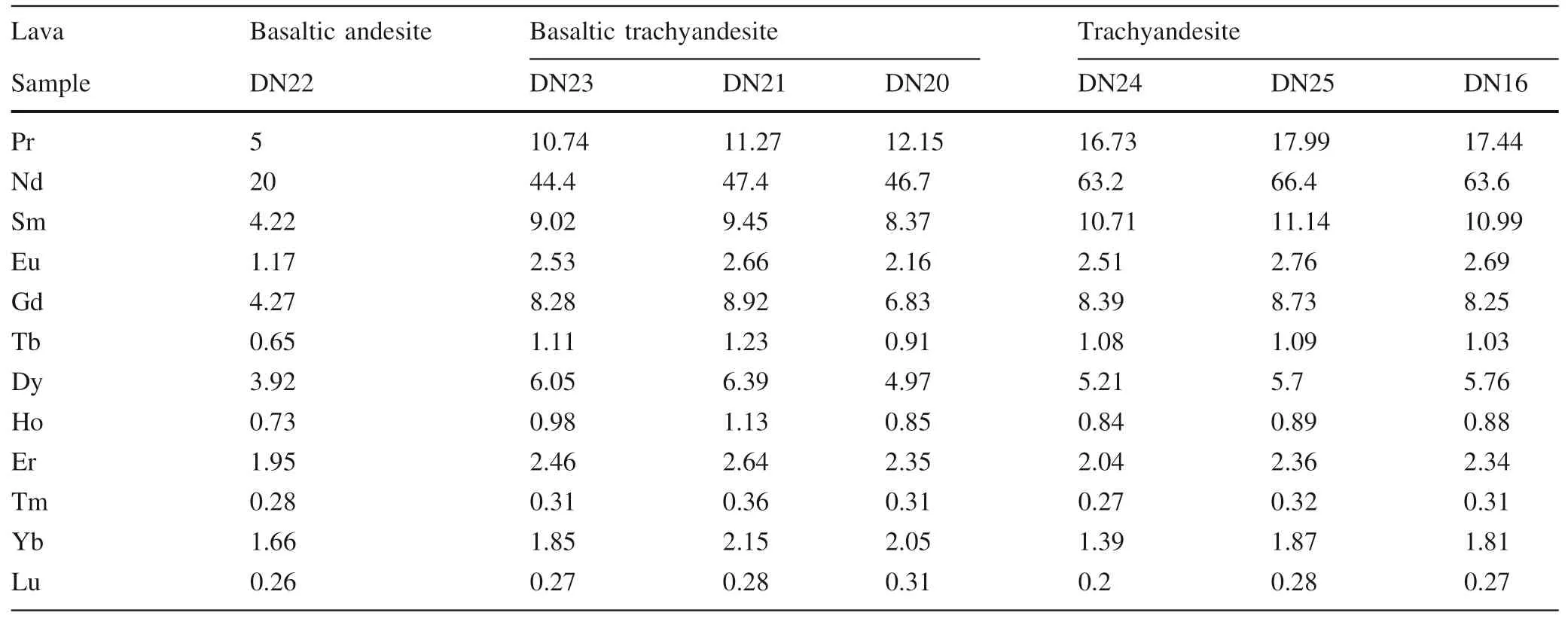
Table 2 continued
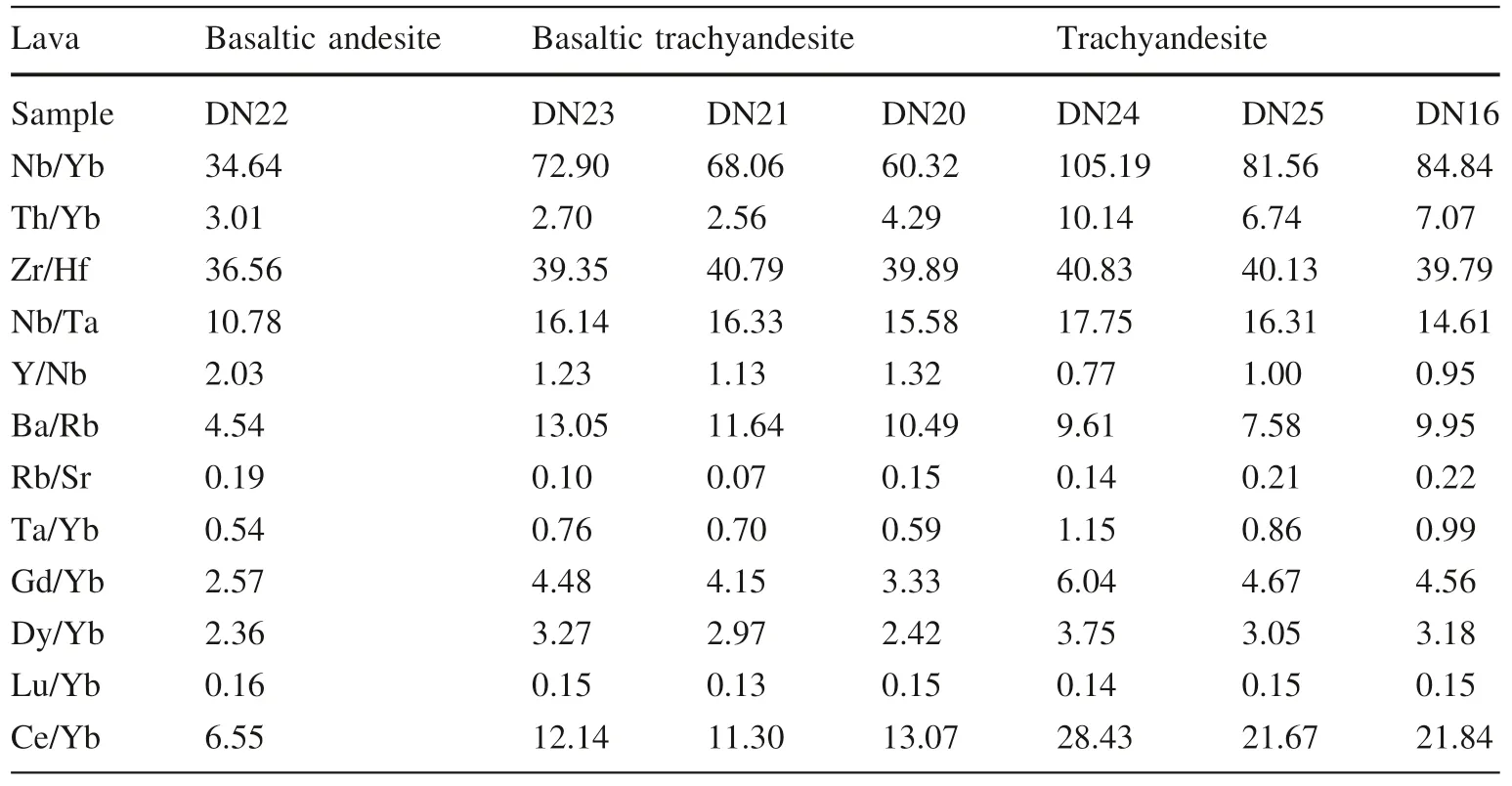
Table 3 Ratios of trace element and REE of Temte´dolerites
In TiOvs Y/Nb diagram(Fig.6),TiO-poor(1.22 wt%),basaltic andesite falls within the continental tholeiite f ield.Slightly evolved rocks(from basaltic trachyandesite to trachyandesite)fall in the overlapping f ields for continental tholeiite and alkaline rock.In(Th–3Tb–2Ta)diagram,two basaltic trachyandesites plot in the continental tholeiites f ield while the basaltic andesite plots close to it(Fig.7).Representative points of the seven rocks are plotted for discussion in this f igure although only the maf ic ones must be considered.

Fig.6 Composition of Temte´dolerites plotted in TiO2 vs Y/Nb diagram after Floyd and Winchester(1975)

Fig.7 Composition of Temte´dolerites plotted in(Th–3Tb–2Ta)triangle after Cabanis and Thie´blemont(1988),BAB:Back-Arc Basin Basalts,CT:Continental Tholeiites;1.Orogenic Basalts,2.Continental Tholeiites and Arc Basin Basalts and 3.Non orogenic Basalts.Representative points of the seven rocks are plotted for discussion although only the maf ic ones must be considered
Primitive-mantle normalized(according to McDonough and Sun 1995)REE patterns are shown in Fig.8a.Patterns show a regular decrease from LREE to HREE with slightly negative anomalies in Eu(Eu/Eu*between 0.8 and 0.9).La contents are high and may reach more than 100 times the primitive mantle values of McDonough and Sun(1995).Gd/Yb ratios are low(2.6)in basaltic andesite and high from basaltic trachyandesite to trachyandesite(3.3–6).Values of Ce/Yb ratios are low in basaltic andesite(6.5)and high in others lavas(11.3–28.4).Normalized values of(Tb/Yb)n ratios are low in basaltic andesite(1.7)and relatively high in others lavas(2.0–3.4)with high contents been found in basaltic trachyandesite DN20.Spider diagram of trace elements(Fig.8b)normalized to primitive mantle(McDonough and Sun 1995)show decreasing values from highly incompatible to compatible elements.Negative anomalies are shown in Nb and Ta and P,Sm,and Ti.Slightly positive anomaly is shown in Y.Normalized K values are high.

Fig.8 Normalized(after McDonough and Sun 1995)REE(a)and Multielements spiderdiagram(b)of Temte´dolerites
8 Discussion
8.1 Tectonic setting
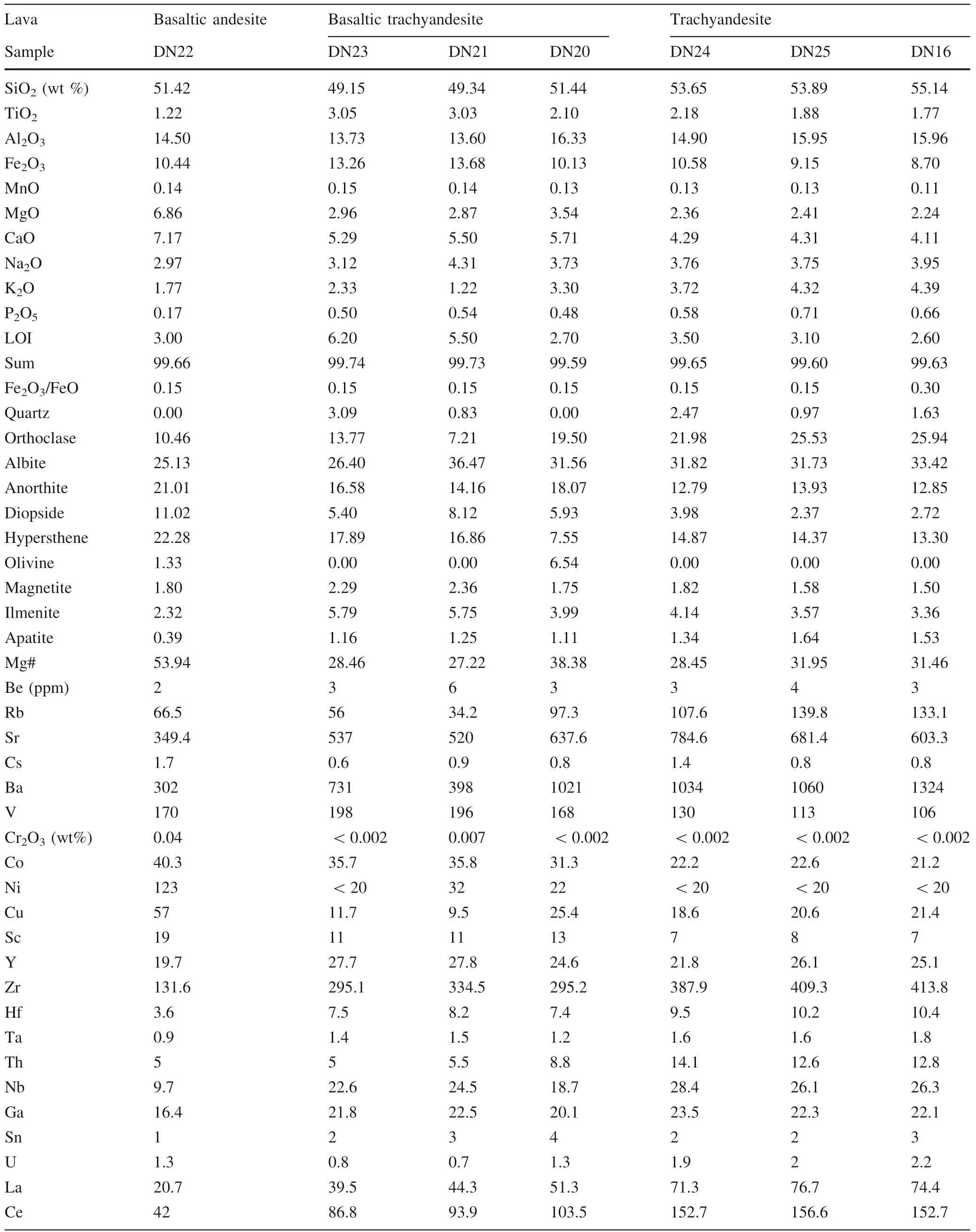
Lava Basaltic andesite Basaltic trachyandesite Trachyandesite Sample DN22 DN23 DN21 DN20 DN24 DN25 DN16 SiO2(wt%) 51.42 49.15 49.34 51.44 53.65 53.89 55.14 TiO2 1.22 3.05 3.03 2.10 2.18 1.88 1.77 Al2O3 14.50 13.73 13.60 16.33 14.90 15.95 15.96 Fe2O3 10.44 13.26 13.68 10.13 10.58 9.15 8.70 MnO 0.14 0.15 0.14 0.13 0.13 0.13 0.11 MgO 6.86 2.96 2.87 3.54 2.36 2.41 2.24 CaO 7.17 5.29 5.50 5.71 4.29 4.31 4.11 Na2O 2.97 3.12 4.31 3.73 3.76 3.75 3.95 K2O 1.77 2.33 1.22 3.30 3.72 4.32 4.39 P2O5 0.17 0.50 0.54 0.48 0.58 0.71 0.66 LOI 3.00 6.20 5.50 2.70 3.50 3.10 2.60 Sum 99.66 99.74 99.73 99.59 99.65 99.60 99.63 Fe2O3/FeO 0.15 0.15 0.15 0.15 0.15 0.15 0.30 Quartz 0.00 3.09 0.83 0.00 2.47 0.97 1.63 Orthoclase 10.46 13.77 7.21 19.50 21.98 25.53 25.94 Albite 25.13 26.40 36.47 31.56 31.82 31.73 33.42 Anorthite 21.01 16.58 14.16 18.07 12.79 13.93 12.85 Diopside 11.02 5.40 8.12 5.93 3.98 2.37 2.72 Hypersthene 22.28 17.89 16.86 7.55 14.87 14.37 13.30 Olivine 1.33 0.00 0.00 6.54 0.00 0.00 0.00 Magnetite 1.80 2.29 2.36 1.75 1.82 1.58 1.50 Ilmenite 2.32 5.79 5.75 3.99 4.14 3.57 3.36 Apatite 0.39 1.16 1.25 1.11 1.34 1.64 1.53 Mg# 53.94 28.46 27.22 38.38 28.45 31.95 31.46 Be(ppm) 2 3 6 3 3 4 3 Rb 66.5 56 34.2 97.3 107.6 139.8 133.1 Sr 349.4 537 520 637.6 784.6 681.4 603.3 Cs 1.7 0.6 0.9 0.8 1.4 0.8 0.8 Ba 302 731 398 1021 1034 1060 1324 V 170 198 196 168 130 113 106 Cr2O3(wt%) 0.04 <0.002 0.007 <0.002 <0.002 <0.002 <0.002 Co 40.3 35.7 35.8 31.3 22.2 22.6 21.2 Ni 123 <20 32 22 <20 <20 <20 Cu 57 11.7 9.5 25.4 18.6 20.6 21.4 Sc 19 11 11 13 7 8 7 Y 19.7 27.7 27.8 24.6 21.8 26.1 25.1 Zr 131.6 295.1 334.5 295.2 387.9 409.3 413.8 Hf 3.6 7.5 8.2 7.4 9.5 10.2 10.4 Ta 0.9 1.4 1.5 1.2 1.6 1.6 1.8 Th 5 5 5.5 8.8 14.1 12.6 12.8 Nb 9.7 22.6 24.5 18.7 28.4 26.1 26.3 Ga 16.4 21.8 22.5 20.1 23.5 22.3 22.1 Sn 1 2 3 4 2 2 3 U 1.3 0.8 0.7 1.3 1.9 2 2.2 La 20.7 39.5 44.3 51.3 71.3 76.7 74.4 Ce 42 86.8 93.9 103.5 152.7 156.6 152.7
The Temte´dykes in Central North Cameroon belong undoubtedly to the category of giant dykes according to Bryan and Ernst(2008)classif ication scheme,because they are more than 3 m-wide(actually between 15 and 30 m).The occurrence of such dykes suggests the existence of former cracks of the same size fed by turbulent magma f lows as modeled by Campbell(1985),in an extensional crustal setting evidenced by the thin crust of Poli basement(23 km,Dorbath et al.1986).This feeding scenario compatible with magma–crust interaction is supported by the occurrence of 2 to 7 cm-size granitoid enclaves.Temte´dyke swarms mainly trend N20°E to N40°E i.e.NNE–SSW to NE–SW.Former interpretations(Dumont et al.1985)have linked these trends to the regional foliation which has affected the basement of northern Cameroon Pan-African Mobile Belt.Temte´dykes should not be considered as time markers of D1-related foliation,as there are not any signs of structural deformation undergone by studied dolerite(Fig.2),nor deformation observed in thin sections(Fig.3).Their occurrence may rather be related to the younger(U–Pb age of 580 Ma)shortening D3 deformation phase evidenced by Toteu et al.(2001),as the directions are similar.Temte´dykes warms may be considered as f ingerprints of either(1)the last deformation phase related to the Pan-African orogeny or(2)the phase of relaxation of the same orogeny,as it ends with the emplacement of intruded granitoids of 545 Ma age in an extensional context(Toteu et al.2001),or(3)a regional tectonic episode unrelated to Pan-African when considering a long and complex crustal evolution of the Poli basement,beginning in the late Archean and extending to the late Neoprotozoic(Toteu et al.2001).The dykes should be relatively younger than the granitoids of the Poli basement,i.e.between 630(Toteu et al.1987)and 530 Ma,respectively the ages of D3 deformation and the post-granitic formation of Gode´massif(Dumont et al.1985),marking the late uplift stage of the Pan-African Belt.Whatever the tentative hypotheses proposed to explain the Temte´dyke swarms occurrence,further studies based on absolute U–Pb geochronological data should be achieved to better constrain its geodynamic signif icance.
The most maf ic lava of the series,DN22 basaltic andesite(DI=35.6),evidences some aff inities with subalkaline lavas as well as continental tholeiites(see Figs.5,6 and 7).This rock is TiO-poor(1.22 wt%)and Zr-poor(131.6 ppm).In Zr/Ti versus Nb/Y diagram(Fig.9a,after Pearce 1982,modif ied from Winchester and Floyd 1977),the previous rock denominations are conf irmed.The basaltic andesite and the three basaltic trachyandesites appear as the most maf ic rocks,while trachyandesites are rather evolved.In Ti/Zr diagram(Fig.9b,after Pearce 1982),the basaltic andesite plots close the limit between the f ield of Within Plate lavas and those of MORB.Representative points of the seven rocks are plotted for discussion in this f igure although only the most maf ic one(DN22)must be considered.

Fig.9 a Zr/Ti versus Nb/Y diagram after Pearce(1982,modif ied from Winchester and Floyd 1977),b Ti/Zr diagram after Pearce(1982)
8.2 Petrogenesis
8.2.1 Mantle source
Whole-rock and mineral phase geochemical analyses are proposed to discuss the petrogenesis of Temte´dolerite dyke swarms.
Basaltic andesite sample DN22 presents the most primitive characters: MgO=6.9 wt%, Mg#=53.94,Ni=123 ppm,CrO=0.04 wt%,DI=35.59.In Fig.5(TAS diagram),the representative point of basaltic andesite DN22 plots on the line between alkaline and subalkaline f ields as def ined by Miyashiro(1978).This aff inity with continental tholeiite is conf irmed in geochemical diagrams(Figs.6 and 7),supporting the emplacement of dolerites in the intracontinental extensional setting.Moreover,two basaltic trachyandesites(DN21 and DN23)also plot in the continental tholeiite f ield in Fig.7.In SiOvs AlO(after LeBas 1962)and(Ti+Cr)vs Ca(apfu)of Leterrier et al.(1982)(Figs.not shown),clinopyroxene compositions shift from subalkaline to slightly alkaline f ield.
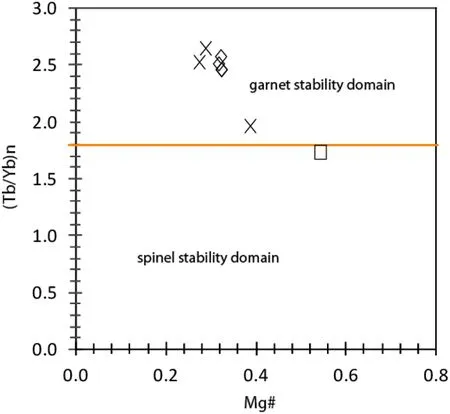
Fig.10(Tb/Yb)n vs Mg#diagram after Wang et al.(2002).Tb and Yb are normalized according to McDonough and Sun(1995).Same symbols as Figs.5 and 6.Temte´dolerites plot in garnet f ield
Ni and Co contents of Temte´dolerites are lower than mantle values(McDonough and Sun 1995)and may indicate(1)that the source was either depleted in these elements or(2)they were retained by compatible refractory phases during partial melting of the mantle source or(3)this may be caused by extensive fractional crystallization.
Garnet phases should be the main refractory minerals as suggested the relatively high values(>2)of Dy/Yb ratios of studied lavas(Shaw et al.2003)and their(Tb/Yb)n values≥1.8(Fig.10,Wang et al.2002).This source should also be phlogopite-bearing as indicated by low Ba/Rb(<20)and Rb/Sr ratios higher than 0.1(Furman and Graham 1999)but this must remain only indicative as these elements could have been mobilized during alteration evidenced by LOI=3 wt%.Moreover,various sources,different degrees of partial melting,fractional crystallization,and crustal contamination can inf luence geochemical data of maf ic rocks.
The low values(0.07–0.15)of Rb/Sr ratios of Temte´basaltic trachyandesites may result from metasomatism process or hydrothermal f luids as also indicated by the high contents of Ba(Sengupta et al.2014).
High Th/Yb ratios as shown in Fig.11 suggest the involvement of a deep–crustal recycling continental sediment and point out the EM II(enriched mantle according to Zindler and Hart 1986)as a potential source of Temte´dolerites(Hofmann 1997;Pearce 2008).Relatively constant values of Zr/Hf and Nb/Ta or their low fractionation should be linked to the same source features and the limited role of f luid phase circulation,respectively(El Tohamy 2019).Rather high Y/Nb ratios of Temte´dolerite attest their tholeiite aff inity while the low values of these ratios especially in trachyandesites may suggest the contribution of continental crust during their evolution.Slopes of the prof iles(Fig.8a)are consistent with LREE and more incompatible elements enrichment relative to HREE and incompatible elements.This suggests a middle to a rather high degree of partial melting source as shown by the fairly low value of(Ce/Yb)n ratio of basaltic andesite.
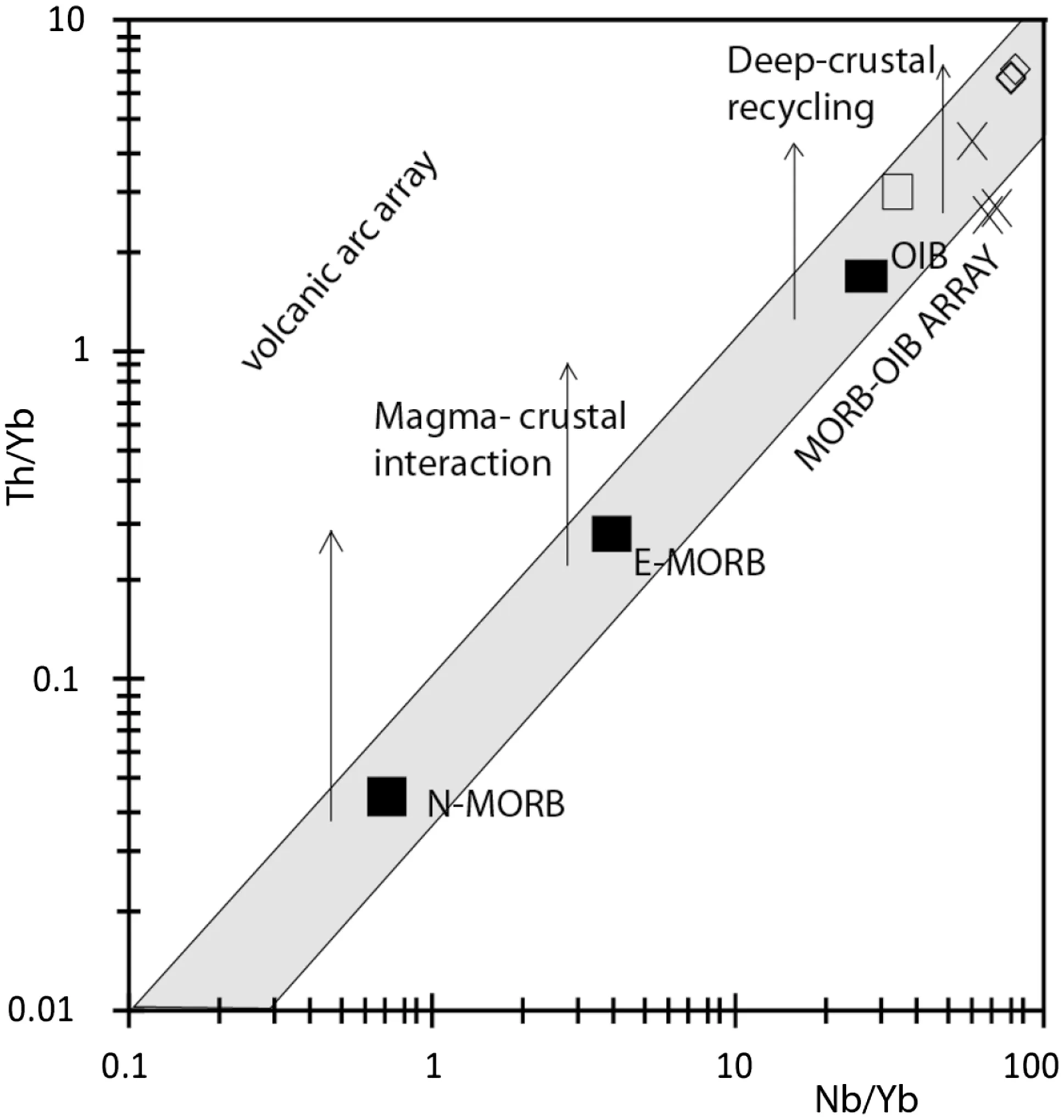
Fig.11 Th/Yb vs Nb/Yb diagram after Pearce(2008).Temte´dolerites plot close to the deep–crustal recycling f ield in the MORB–OIB array.Same symbols as Figs.5 and 6
Note that the high LREE/HREE ratio(i.e.strong HREE depletion)shows some similitude with adakitic rocks.This could be conf irmed by the occurrence of amphibole phenocrysts(Fig.3b)and also rather high contains in Ba,Sr,and La,as well as Sr/Y and La/Yb ratios.In fact,these rocks differ by several aspects from typical adakite as def ined by Defant and Drummond(1990,1993),which contain 56–70 wt%SiOand are AlOand NaO rich but KO poor.
8.2.2 Magmatic differentiation
Dolerites of Temte´evidence a limited series,from basaltic andesite (DI=35.6) to basaltic trachyandesites(43.3–51.1)and trachyandesites(56.3–61).Fractional crystallization of maf ic phases is invoked.Weakly Eu anomalies(Eu/Eu*between 0.8 and 0.9)suggest limited feldspar fractionation during this process.The range of Lu/Yb between 0.13 and 0.16 indicates that the parental melt of the series is mantle-derived(Sun and McDonough 1989)and is the result of a moderate to a fairly high partial melting rate of the EM II mantle source.
With differentiation,intermediate rocks became more and more alkaline that explains their representative points in alkaline f ield of TAS diagram(Fig.5).In the same way,they plot in the overlapping area between alkaline and tholeiitic f ields in Fig.6.
9 Conclusion
Petrographical observations,electron microprobe,and whole-rock chemical analyses showed that Temte´dolerite dykes display some continental tholeiite aff inities,but close to alkaline and could originate from deep EM II mantle source,after moderate to high partial melting rate.They evolved through fractional crystallization from basaltic andesite to trachyandesite via basaltic trachyandesite.Some lavas could have been slightly contaminated by crustal materials.Dolerites emplacement may have been favored by a thinner continental crust in extension after a regional uplift,in an active continental margin type environment,where early rifting led to the formation of the marginal basin.Temte´dolerites moved upwards through a turbulent f low scenario during regional uplift in the context of the extensional setting of back-arc basin formation.
Acknowledgement
s Authors greatly thank the‘‘Agence Universitaire de la Francophonie(AUF)’through the BAGL(Bureau Afrique Centrale et des Grands Lacs)for f inancial support of Le Projet de soutien aux e´quipes de recherche 2012/2013(No 51110SU201)for supplement analyses.This paper is part of MMA thesis.‘‘Laboratoire GEOPS’’of the University Paris-Saclay is thanked for f inancial support of thin sections and electron microprobe analyses.B.Bonin is warmly thanked for his fruitful remarks.Two anonymous reviewers helped us to improve this contribution.Compliance with ethical standards
Conf lict of interest
On behalf of all authors,the corresponding author states that there is no conf lict of interest.杂志排行
Acta Geochimica的其它文章
- Validating the deep time carbonate carbon isotope records:effect of benthic f lux on seaf loor carbonate
- Interaction of Ca2+and soil humic acid characterized by a joint experimental platform of potentiometric titration,UV-visible spectroscopy,and f luorescence spectroscopy
- Trace and rare earth element geochemistry of the black and grey shales of the Calabar Flank,Southeastern Nigeria:constraints on the depositional environment and the degree of metal enrichment
- Geochronological and geochemical comparison of Precambrian meta-maf ic volcanics in Zhongtiaoshan and Lu¨liangshan Regions in Shanxi,North China Craton
- Mineralogy and geochemistry of sands of the lower course of the Sanaga River,Cameroon:implications for weathering,provenance,and tectonic setting
- Episodic crustal growth and reworking at the southeastern margin of the North China Craton:evidence from zircon U-Pb and Lu-Hf isotopes of Archean tonalite-trondhjemite-granodiorite gneisses in the Bengbu-Wuhe area
